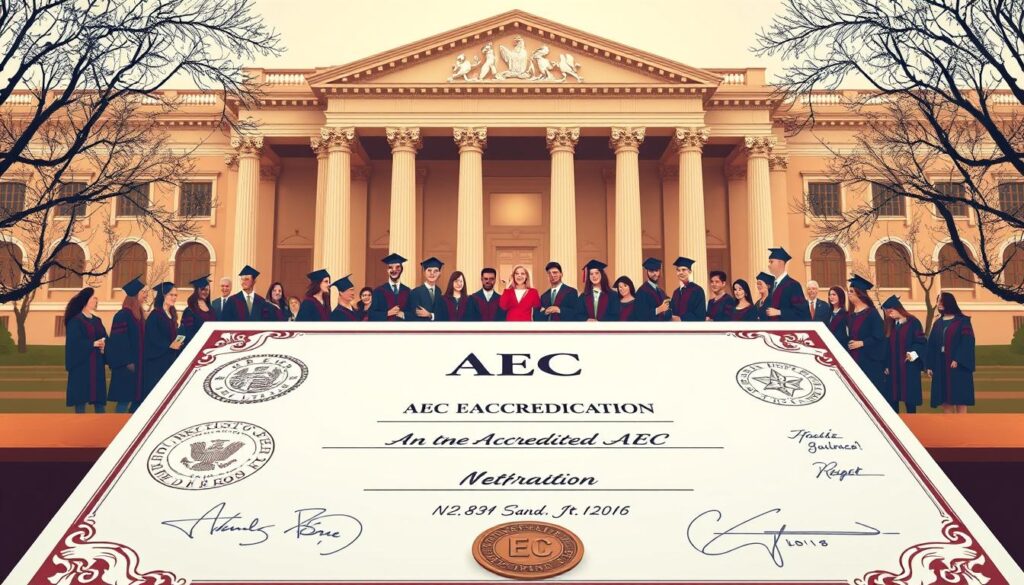AEC License: Unlock Your Career in the Construction Industry
Getting a professional license is key to moving up in the construction industry. The right licensing opens doors to new chances and helps you reach your career dreams.

The AEC license is more than a piece of paper. It shows you’re ready to shine in your field. We’ll look at why an AEC license matters and how to get one.
By the end of this, you’ll know how licensing can help your career. And what steps to take to start.
Understanding AEC Licenses
In the AEC sector, getting a license is more than a formality. It’s key to showing you’re credible and skilled. The process checks if you meet the standards to work in your field.
What is an AEC License?
An AEC license shows you’re certified in Architecture, Engineering, and Construction. It means you’ve passed education, experience, and exam tests. This license proves you’re competent and follow ethical rules.
The Importance of Licensing in Construction
Licensing in construction keeps quality, safety, and professionalism high. It makes sure workers are qualified. This protects the public and lowers project failure risks.
Regulatory Bodies Overseeing AEC Licensing
Many groups watch over AEC licensing. They set rules, give exams, and check if people follow them. State boards and groups like the American Institute of Architects (AIA) and the National Council of Examiners for Engineering and Surveying (NCEES) are examples.
The AEC industry is complex, with many professionals needing specific licenses. This includes architects, engineers, construction managers, and specialty trade contractors. Each group has its own set of licenses to follow.
Architectural Licenses
Architects are key in designing buildings and structures. To become a licensed architect, one must get:
- Registered Architect (RA) License: This license is vital for architects who want to sign off on projects and work directly with clients.
- LEED Accreditation: LEED (Leadership in Energy and Environmental Design) accreditation shows an architect’s skill in sustainable design. It’s not a license but a prestigious credential.
Engineering Licenses
Engineers are crucial in the AEC industry, making sure projects are safe and work well. Important licenses include:
- Professional Engineer (PE) License: This license is key for engineers working on projects that affect public safety.
- Structural Engineering License: This license is for engineers who focus on the structural integrity of buildings and structures.
Construction Management Licenses
Construction managers handle projects from start to finish, ensuring they’re done on time and within budget. Key certifications are:
- Certified Construction Manager (CCM): This certification shows a construction manager’s expertise and knowledge.
- Project Management Professional (PMP): PMP certification is valued in the industry for project management skills, though it’s not specific to construction.
Specialty Trade Licenses
Specialty trade contractors, like electricians and plumbers, need licenses to work. Important licenses include:
| Trade | License | Description |
| Electrical | Electrical Contractor License | Required for electricians to legally work on electrical systems. |
| Plumbing | Plumbing Contractor License | Necessary for plumbers to work on plumbing systems. |
Knowing about these licenses is the first step to a successful career in the AEC industry. Each license and certification has its own needs and benefits, fitting the specific roles within the field.
Benefits of Obtaining an AEC License
Getting an AEC license brings many benefits. It boosts your professional standing and opens up new career paths. It shows you’re among the best in architecture, engineering, and construction.
Professional Credibility and Recognition
Having an AEC license greatly increases your professional credibility. It proves you’re an expert and dedicated to your field. This earns you respect from your peers and clients.
Expanded Job Opportunities
An AEC license leads to more career advancement chances. You can apply for better jobs and work on bigger projects. These roles need your special skills and knowledge.
Higher Earning Potential
Licensed AEC pros make more money than those without a license. The license is often needed for higher-paying jobs. It shows you’re worth more to your company.
Legal Protection and Compliance
An AEC license also gives you legal protection. It makes sure you follow state and national laws. This keeps you safe from legal trouble and shows you’re committed to doing things right.
In short, getting an AEC license is smart for your career. It helps you grow professionally, find better jobs, and earn more. Plus, it keeps you on the right side of the law.
Educational Requirements for AEC Licenses
To become a licensed AEC professional, you must first meet certain educational requirements. These requirements are set to ensure you have the right knowledge and skills. They prepare you for success in your chosen field.
Degree Programs and Accreditation
Getting a license usually means finishing an accredited degree in a field like architecture, engineering, or construction management. Accreditation is key. It makes sure the program is up to industry standards and offers a quality education.

Supplementary Courses and Certifications
Along with degrees, taking extra courses and getting certifications can boost your skills. You might learn about sustainability, project management, or building information modeling (BIM).
Internship and Practical Experience Requirements
Practical experience is crucial in AEC education. Many need to do an internship or get a certain amount of work experience before they can take the licensing exam.
Alternative Pathways for Non-Traditional Students
Non-traditional students have options too. They can look into online degrees, part-time studies, or getting credit for work experience through recognition of prior learning (RPL).
The AEC License Application Process
To apply for an AEC license, you need to know the process well. It has key parts that must be handled right to succeed.
Documentation and Paperwork
The first thing is to collect all needed documents. You’ll need your school records, work history, and references. Make sure everything is correct and complete.
Application Fees and Timelines
Applying for an AEC license costs money, and prices vary. It’s important to know how much and when to pay. Also, how long it takes to process can change a lot.
Background Checks and Verification
Many places do background checks as part of getting a license. This checks if you’re honest and reliable. Always tell the truth and be open.
Common Application Mistakes to Avoid
Don’t make common errors like missing documents or wrong payments. Knowing these mistakes can help you avoid them.
| Application Component | Description | Timeline |
| Documentation | Gathering educational transcripts, work experience, and references | 2-4 weeks |
| Application Fees | Payment of licensing fees | Upon submission |
| Background Checks | Verification of professional and personal background | 4-6 weeks |
Understanding and managing each part of the AEC license application can boost your success chances.
Preparing for AEC Licensing Exams
With the right study approach and understanding of the exam format, you can feel ready for the AEC licensing exam.
Study Resources and Materials
It’s key to have the right study resources and materials for the AEC licensing exam. You need a variety of study aids to fit your learning style.
Recommended Books and Guides
There are many books and guides recommended for AEC exam prep. They cover a wide range of topics and offer deep knowledge needed for the exam.
- Textbooks on architecture, engineering, and construction management
- Study guides specifically designed for the AEC licensing exams
- Practice exams to help assess your knowledge and identify areas for improvement
Online Courses and Prep Programs
Online courses and prep programs offer flexible learning options. They include interactive content, video lectures, and online forums for discussion.
Exam Structure and Format
Knowing the exam structure and format is key for good prep. The exam has multiple sections, each testing different knowledge and skills.
| Exam Section | Description | Time Allocation |
| Multiple Choice | Tests knowledge of fundamental concepts | 60 minutes |
| Case Studies | Assesses application of knowledge to real-world scenarios | 90 minutes |
Test-Taking Strategies
Using effective test-taking strategies can boost your AEC licensing exam score. This includes managing your time well, reading questions carefully, and using the process of elimination for multiple-choice questions.

Common Challenges and How to Overcome Them
Many face challenges like time management, anxiety, and difficulty with certain topics. To beat these, create a study plan, practice under timed conditions, and seek help when needed.
State-Specific AEC License Requirements
Getting an AEC license can be tricky due to state rules. Each state has its own rules for getting a license. It’s key for professionals to know the rules in their state.
Variations in Licensing Across States
States have different rules for AEC licenses. Some might need extra certifications or stricter education. AEC pros need to know the rules in the state they want to work in.
Reciprocity Agreements Between States
Some states let AEC pros with a license in one state work in another without a new license. But, these deals can be tricky and change often. It’s important to understand these agreements for those working across state lines.
Multi-State Licensing Considerations
AEC pros working on projects in many states need to know each state’s rules. They might need to get licenses for each state or make sure their current one is good everywhere.
International License Recognition
AEC pros with licenses from outside the U.S. might need to get theirs recognized in the U.S. This can take a lot of time and needs careful planning.
In short, knowing the AEC license rules in each state is crucial. By understanding these rules, professionals can follow the law and grow their careers.
Maintaining Your AEC License
To keep an AEC license, you need to follow several important steps. These steps help you stay up-to-date and competitive. Knowing the rules and procedures for license upkeep is crucial.
Continuing Education Requirements
Continuing education is key for AEC license renewal. You must finish a certain number of hours or credits within a set time frame.
Approved Course Providers
Choose courses from approved providers. This makes sure your continuing education credits count.
Documentation of Completed Credits
Keep accurate records of your credits. You’ll need these for the license renewal process.
| State | Continuing Education Hours Required | Renewal Period |
| California | 30 hours | 2 years |
| New York | 36 hours | 3 years |
| Texas | 24 hours | 2 years |
License Renewal Procedures
Renewing your license varies by state. You’ll need to submit an application, pay fees, and show proof of continuing education.
Staying Current with Industry Changes
Stay informed about new technologies, regulations, and best practices. This keeps you ahead in the AEC field.
Consequences of License Lapse
Letting your AEC license lapse can lead to big problems. You might face fines, penalties, and have to reapply for licensure.
Career Advancement Opportunities with an AEC License
An AEC license opens doors to many career paths in architecture, engineering, and construction management. It boosts your career and leads to new, exciting roles.
Career Paths in Architecture
Licensed architects can move up to senior design roles or lead architectural firms. They can also focus on sustainable design and historic preservation. Roles in urban planning and project management are also available.
Engineering Career Trajectories
Engineers with an AEC license can become senior project managers or leading experts. They can also start their own consulting firms. Specializing in areas like structural, mechanical, or electrical engineering is in high demand.
Construction Management Roles
Construction managers with an AEC license can manage large projects or run construction firms. Their skills are key to completing projects on time and on budget.
Entrepreneurial Opportunities
An AEC license is great for starting your own business or offering consulting services. You can offer architectural and engineering services, construction management, or specialized consulting.
Starting Your Own Firm
With an AEC license, you have the credibility to start a successful firm. You’ll need a business plan, funding, and a team of professionals.
Consulting Services
Licensed AEC professionals can offer consulting services to various industries. This includes project management, design consulting, and expert testimony.
| Career Path | Potential Roles | Specializations |
| Architecture | Senior Designer, Project Manager | Sustainable Design, Historic Preservation |
| Engineering | Senior Project Manager, Consulting Engineer | Structural, Mechanical, Electrical Engineering |
| Construction Management | Project Manager, Construction Firm Manager | Project Oversight, Budgeting |
Career advancement opportunities are plentiful for AEC professionals with a license. By exploring different paths and entrepreneurial ventures, they can achieve significant professional growth and success.
Salary Expectations for Licensed AEC Professionals
Licensed AEC professionals have a wide range of salary expectations. This range goes from entry-level to executive positions. The pay varies based on experience, location, and job role.
Entry-Level Positions
Entry-level AEC professionals start with competitive salaries. The average starting salary for licensed architects is about $55,000. Engineers start around $65,000.
Mid-Career Earnings
As AEC professionals gain experience, their salaries rise. Mid-career architects and engineers can earn between $80,000 to over $100,000. This depends on their specialization and location.
Senior and Executive Compensation
Senior and executive AEC professionals earn the most. Their salaries range from $120,000 to over $200,000. This is especially true in high-demand markets and big cities.
Regional Salary Variations
Regional variations greatly affect AEC professionals’ salaries. Metropolitan areas often pay more than rural areas. This is because of the higher cost of living and demand for services.
Metropolitan vs. Rural Areas
The difference between metropolitan and rural areas is clear. For example, licensed architects in cities like New York or San Francisco earn more. This is compared to those in rural areas.
High-Demand Markets
High-demand markets, like major construction hubs, offer high salaries. These markets attract top talent with large-scale projects. Experienced AEC professionals are needed for these projects.
Conclusion: Leveraging Your AEC License for Long-Term Success
Getting an AEC license is a big step in your career. It shows you’re an expert and serious about the construction field. This license boosts your credibility and opens doors to better jobs and more money.
To keep your career growing, make sure to keep your AEC license up to date. Keep learning and following the rules. This way, you’ll stay ahead in the industry and meet new project needs.
Your AEC license can help you grow in your career. You can handle bigger projects and even start your own business. No matter your role, your license is a key to success and new challenges.
Now, focus on using your AEC license to the fullest. Aim for a fulfilling and successful career in construction.
